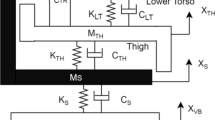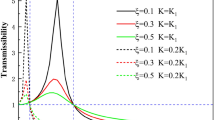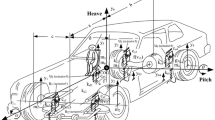Abstract
This article focusses on reducing the axis acceleration and minimizing the vertical displacement by using an air spring actuator and active force control as a main control element. In active force control loop track the developed force of an air spring actuator is fed as a feedback to the actuator. Mamdani and sugeno type fuzzy interference system are used to develop a desired force and to estimate mass of the system respectively. The performance of the system is analyzed for both time and frequency domains and contrasted with passive suspension due to the irregular road disturbances. While developing the simulation model, quarter car suspension with seat as three degree of freedom and an air spring actuator acting as a force generator are modeled as non-linear system. The simulation result shows the effectiveness of the proposed control scheme in suppressing the undesirable effects of the suspension system.
Similar content being viewed by others
References
M. A. Eltantawie, Decentralized neuro-fuzzy control for half car with semi-active suspension system, International Journal of Automotive Technology, 13(3) (2012) 423–431.
M. Geravand and N. Aghakhani, Fuzzy sliding mode control for applying to active vehicle suspentions, Wseas Transactions on Systems and Control, 5 Jan (2010).
M. Mailah and G. priyandoko, simulation of a suspension with adaptive fuzzy active force control, Int Simul model, 6(1) (2007) 25–36.
Mouleeswaran Senthil kumar, Genetic algorithm-based pro-portional derivative controller for the development of active suspension system, Information Technology and Control, 36(1) (2007).
Ali M. Abd-El-Tawwab, Theoretical and experimental fuzzy control on vehicle pneumatic semi-active suspension system, Journal of American Science, 9(1) (2013).
J. Hurel, A. Mandow and A. García-Cerezo, Tuning a fuzzy controller by particle swarm optimization for an active suspension system, 38th Annual Conference on IEEE Industrial Electronics Society, 25–28 Oct (2012) 2524–2529.
S. yildirim and I. eski, Vibration analysis of an experimental suspension system using an artificial neural networks, Journal of scientific and Industrial research, 60 june (2009) 522–529.
A. Aldair and W. J. Wang, Adaptive neuro fuzzy inference controller for full vehicle nonlinear active suspension systems, Iraq J. electrical and electronic engineering, 6(2) (2010).
Y. Hacioglu and N. Yagiz, Control of vehicle active suspensions by using PD+PI type fuzzy logic with sliding surface, Journal of Physics: Conference Series 410 012002 (2013).
A. Giua, C. Seatzu and G. Usai, Semi-active suspension design with an Optimal Gain Switching target, Vehicle System Dynamics, 31 (1999) 213–232.
K. J. Kitching, D. J. Cole and D. Cebon, Performance of semiactive damper for heavy vehicles, ASME Journal of Dynamic Systems Measurement and Control, 122 (2000) 498–506.
A. Giua, M. Melas, C. Seatzu and G. Usai, Design of a predictive semi-active suspension system, Vehicle System Dynamics, 41(4) Apr (2004) 277–300.
G Priyandokoa and M Syakirinr, Modelling of MR damper with adaptive neural network and particle swarm optimisation technique, Latest Trends in Circuits, Control and Signal Processing.
H. Metered, P. Bonello and S. O. Oyadiji, The experimental identification of magnetorheological dampers and evaluation of their controllers, Mechanical Systems and Signal Processing, 24(4) (2010) 976–994.
Devdutt, M. L. Aggarwal, Fuzzy control of seat vibrations for semi-active quarter vehicle system utilizing magneto rheological damper, International Journal of Engineering Inventions, 1(12) Dec (2012) 51–56.
R. Rosli and M. mailah, Active force control with iterative learning control algorithm applied to vehicle suspension system, Latest Trends in Circuits, Control and Signal Processing.
Nusantoro, G. Priyandoko, PID state feedback controller of a quarter car active suspension system, J. Basic. Appl. Sci. Res., 1(11) (2011) 2304–2309.
M. Presthus, Derivation of air spring model parameters for train simulation. Master’s Thesis, Department Of Applied Physics And Mechanical Engineering, Lulea University Of Technology, Sweden (2002).
V. Gavriloski and J. Jovanova, Dynamic behavior of an air spring elements.
G. Quaglia and M. Sorli, Air suspension dimensionless analysis and design procedure, Veh. Syst. Dyn., 35 (2001) 443–475.
W. N. Bao, L. P. Chen, Y. Q. Zhang and Y. S. Zhao, Fuzzy adaptive sliding mode controller for an air spring active suspension, International Journal Of Automotive Technology, 13(7) (2012) 1057–1065.
M. M. M. Salem and A. A. Ayman, Fuzzy control of a quarter-car suspension system, World Academy Of Science, Engineering and Technology (2009) 53.
K. Rajeswari and P. Lakshmi, Simulation of suspension system with intelligent active force control, IEEE International Conference (2010).
J. R. Hewit and J. S. Burdess, Fast dynamic decoupled control for robotics using active force control, Transactions on Mechanisms and Machine Theory, 16(5) (1981) 535–542.
K. Ramji, A. Gupta, V. H. Saran, V. K. Goel and V. Kumar, Road roughness measurements using PSD approach, Journal of the Institution of Engineers, 85 (2004) 193–201.
International organization for standardization, Mechanical vibration and shock, Evaluation of human exposure to whole-body vibration — Part 1: General requirements, ISO 2631-1 (1997).
Author information
Authors and Affiliations
Corresponding author
Additional information
Recommended by Editor Yeon June Kang
Sathishkumar. P. completed his master’s degree in Automobile Engineering from Anna University Chennai, INDIA. After which he is pursuing Ph.D. at the same Institute under the faculty of Mechanical Engineering. His primary interest is control of Semi active and Active suspension system.
Rights and permissions
About this article
Cite this article
Sathishkumar, P., Jancirani, J. & John, D. Reducing the seat vibration of vehicle by semi active force control technique. J Mech Sci Technol 28, 473–479 (2014). https://doi.org/10.1007/s12206-013-1204-6
Received:
Revised:
Accepted:
Published:
Issue Date:
DOI: https://doi.org/10.1007/s12206-013-1204-6




